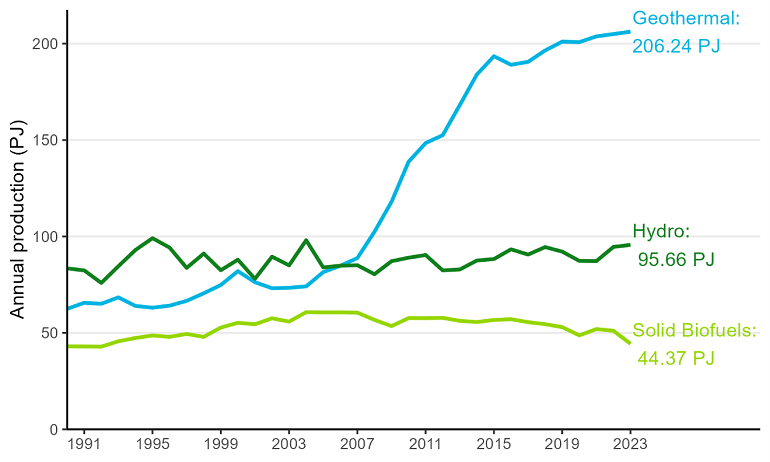Renewables
Renewable energy is often associated with electricity production, specifically wind, solar, or hydro generation. However, renewable energy is also used for direct heat applications such as milk powder drying, paper making, commercial space heating, or Rotorua’s heated pools.
On this page
Geothermal
Geothermal energy is extracted from heat deep beneath the earth’s surface. Kawerau, where geothermal steam is a significant source of energy for pulp and paper mills, is among the world’s largest user of direct geothermal heat concentrated in one location.
Geothermal energy is often used for electricity generation. However, a smaller amount is used for direct heat applications. These uses include drying paper or milk in industrial processes, or in residential or commercial heating, such as the heated pools in Rotorua.
Woody biomass
Pulp and paper mills and wood processors use the majority of woody biomass to provide heat energy and generate electricity. Households use a smaller quantity for space heating.
Black liquor
Black liquor is a dark liquid generated during the paper-making process. Throughout the wood pulping process, chemicals are added to help separate the fibres from the lignin, which acts as a binder holding the fibres together. This resulting combination of chemicals, lignin, and wood fibres is a dark, viscous liquid known as black liquor.
Liquid biofuels
Liquid biofuels are renewable, low-emission fuels that can be blended with petrol and diesel to reduce greenhouse gas emissions from transport. They are also less dependent on new vehicles (for example, electric vehicles or hydrogen fuel cell vehicles) because they can be used in existing internal combustion engine (ICE) vehicles.
Sustainable aviation fuels
Sustainable aviation fuel (SAF) is a type of jet fuel produced from renewable feedstocks, such as vegetable oil or animal fat. It is very similar to traditional fossil jet fuel in its chemical composition and is generally blended with traditional fuel to reduce the emissions of aviation transport.
Biogas
Originating from a variety of non-fossil sources, such as wastewater and sewage, biogas is primarily a mixture of methane and carbon dioxide which is combusted to produce heat and/or electricity.
Sludge gas is derived from the anaerobic fermentation of biomass and solid wastes from sewage. Sludge gas is produced at several municipal wastewater treatment plants around the country, where it is used to generate electricity.
Landfill gas is derived from the anaerobic fermentation of biomass and other organic solid wastes in landfills. About a dozen sites around the country collect landfill gas and use internal combustion engines to produce electricity.
Renewable production and usage fell in 2023
The total supply of renewable energy fell to 363.8 petajoule (PJ) in 2023, a 2.6 PJ drop from 2022. This was driven by a decline in the wood processing sector, which offset increases in hydro, geothermal, solar, wind, and liquid biofuel supply.
Solid biofuel use fell by 13% (6.7 PJ) to 44.4 PJ in 2023. In February 2023, Cyclone Gabrielle caused significant damage to several key wood processing and forestry sites. The Pan Pac mill at Whirinaki was closed for much of the 2023 calendar year to repair silt damage. Along with other impacted sites, this meant a decline in electricity and wood energy demand for the sector.
This led to wood energy use falling below levels seen during the coronavirus (COVID-19) pandemic and is the lowest on record since 1992. This contributed to New Zealand’s renewable share of energy consumption falling slightly to 30.1%, down from 30.9% in 2022.
Geothermal and hydro production remained steady in 2023. In contrast, biogas production continued its long-term increasing trend up 4% (0.13 PJ) in 2023 to 3.8 PJ, mostly driven by increased use of landfill gas for electricity generation.
Figure 9. Renewable energy production by main types – 1990 to 2023 (PJ)

View chart data for figure 9

